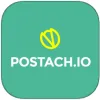Take a look inside 4 images
Postach.io
Pros: Speedy setup and simple interface let users start blogging, communicating, and sharing with ease.
Cons: It's difficult to modify the order of blog posts once they're submitted, and some users might balk at the price.
Bottom Line: A solid, simple tool for turning notes in Evernote into polished-looking blog posts.
On a most basic level, users can share notes and notebooks with the public or create a password-protected blog to share with certain individuals. Students could use Postach.io to showcase and publish their artwork or writings, or possibly create a digital portfolio of work throughout their previous years in school. Teachers might use the tool it as a course site, publishing their lesson plans, course updates, instructions, or tutorials. Students could also email blog posts to their teacher's Evernote email address so that all students could become collaborators on a single blog tied to their teacher's Evernote account. Administrators could use Postach.io as a way to communicate with their faculty and staff, or even with the parent population at their school. Teachers, administrators, or parents could use it as a platform for displaying outstanding student work.
Postach.io is a paid, Evernote-powered blogging platform. When Evernote users sign up for Postach.io, they grant access to their existing notes and notebooks in Evernote. Users quickly choose a blog name and URL, and a blog ending in ".postach.io" will be set up. The user's Evernote interface then has a notebook with the name of the blog. Users can then add notes to this notebook and tag them as "published." Once the Evernote notebook is synced, the blog will update with the latest posts. Keep in mind that blog posts show up in the order they are dated and created, so changing them can only occur when a user manually changes the date in the Evernote note.
Postach.io was previously available free, and users could pay to add premium services. In early 2015, the pricing structure changed: All users pay to use postach.io, and all users can create up to 10 blogs with five collaborators and unlimited content. All users also have access to customizable themes and password protection for their posts.
While the tool itself won't teach students anything in particular, it could be a good vehicle for turning student notes and insights into published posts. Postach.io's blogs have the look of a high-quality site with no fuss, and the service is an attractive tool for students and teachers already using Evernote on a regular basis. Teachers should consider what the best use of a blog in their classroom is; since each blog can only have a limited number of collaborators, teachers might consider hosting a few blogs for their classes and allowing small groups of students to contribute to each one, or they might have students email their posts to the teacher's Evernote email address and post from there. As it is, this could be a great tool for the classroom: Users will take an active role in creating and sharing their knowledge, and there are flexible customization features for personalizing the experience.
The main drawback for postach.io is its price. Since it's only available as a paid service, it may not be a feasible option for teachers and students to use together. However, teachers who already use Evernote heavily for their own writing and note-taking may love the simplicity and flexibility of its features.











